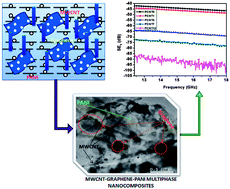Multi-walled carbon nanotube–graphene–polyaniline multiphase nanocomposite with superior electromagnetic shielding effectiveness†
Abstract
The multiphase approach was adapted to enhance the electromagnetic interference (EMI) shielding effectiveness (SE) of polyaniline (PANI) based nanocomposites. The natural graphite flakes (NGF) incorporated modified PANI was used for the development of multi-walled carbon nanotubes (MWCNTs) based nanocomposites. In PANINGF–MWCNTs composites, multilayer graphene was synthesized in situ by ball milling. The resultant PANINGF–MWCNTs nanocomposites were characterized by different techniques. It was revealed from the transmission electron microscope (TEM) observation that in situ derived multilayer graphene acts as a bridge between PANI and MWCNTs, and plays a significant role for improving the properties of multiphase nanocomposites. It was observed that EMI-SE increases with increasing the MWCNTs content from 1 to 10 wt% in the multiphase nanocomposites. The maximum value of total EMI-SE was −98 dB of nanocomposite with 10 wt% of MWCNTs content. The high value of EMI-SE is dominated by the absorption phenomenon which is due to the collective effect of increase in space charge polarization and decrease in carrier mobility. The decrease in carrier mobility has a positive effect on the shore hardness value due to the strong interaction between the reinforcing constituent in multiphase nanocomposites. As a consequence, shore hardness increases from 56 to 91 at 10 wt% of MWCNTs.


 Please wait while we load your content...
Please wait while we load your content...